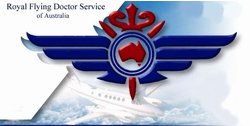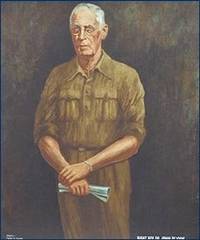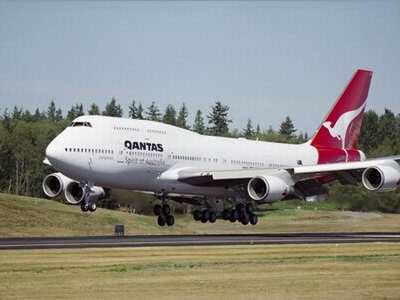Australia's Royal Flying Doctor Service is 75
 The RFDS
began in Cloncurry in north-west Queensland on May 15, 1928, and
two days later made its first flight with a borrowed plane.
The RFDS
began in Cloncurry in north-west Queensland on May 15, 1928, and
two days later made its first flight with a borrowed plane.
A RFDS spokesman said the anniversary was a chance for everyone
in Australia to get behind the not-for-profit service: "It's the
start of a year-long celebration thanking the community for their
past support and seeking their support not only this year but in
the years to come."
The RFDS is a highly-necessary lifeline for Australia's rural
communities. Last year, the RFDS attended an average of 498
people a day (181,621 total), evacuated 59 people a day
(21,604 total), flew 36,571 km a day (13,348,468 km total), made
110 landings a day (40,039 total), using 40 aircraft from 19 bases,
and had a staff of 433.
 The founder of the RFDS was the Very Reverend John
Flynn (right). In 1911 John Flynn took up his first appointment at
Beltana Mission in the north of south Australia. Flynn became very
close to the people of the outback, and in 1912, he was appointed
as the first Superintendent of the Australian Inland Mission,
the 'bush department' of the Presbyterian Church.
The founder of the RFDS was the Very Reverend John
Flynn (right). In 1911 John Flynn took up his first appointment at
Beltana Mission in the north of south Australia. Flynn became very
close to the people of the outback, and in 1912, he was appointed
as the first Superintendent of the Australian Inland Mission,
the 'bush department' of the Presbyterian Church.
He began his missionary work at a time when only two doctors
served an area of some 300,000 sq km in Western Australia and
1,500,000 sq km in the Northern Territory. Flynn began establishing
bush hospitals and hostels in remote outback areas, but while they
provided an important service, they were only really scratching at
the surface of the problem of caring for people in the outback.
Flynn told many tales to illustrate the need for medical care in
the outback. One such story was that of Jimmy Darcy, a stockman
hurt in a fall near Halls Creek, Western Australia in August
1917.
Found badly injured, Darcy was transported by his friends to
Halls Creek, 30 miles away, a 12-hour journey. There, the only
person who knew first aid was the postmaster, F W Tuckett, who
realised Darcy's injuries were serious.
After trying unsuccessfully trying to contact doctors by
telegraph at Wyndham and Derby, he finally thought to telegraph
2,000 miles to his former first aid lecturer, Dr Holland in Perth.
Following diagnosis by morse code, Holland went on to instruct
Tuckett through two long and painful bladder operations with a pen
knife. Holland then set out on a 10-day journey from Perth to Halls
Gap by cattle boat, Model T Ford, a horse-drawn carriage and
finally foot. When he arrived he found that although the operations
were successful, Darcy, weakened by undiagnosed malaria and an
abscessed appendix, had died the day before.
The tragedy elbowed war news from many Australian newspapers,
and more than any other single event, attracted nationwide
attention to the urgent need for doctors, hospitals and nurses in
outback Australia.
It took Flynn another decade to raise sufficient funds, but on
15 May 1928, the Aerial Medical Service was established as a
one-year experiment at Cloncurry in Queensland. After many years of
dreaming, hard work and planning the Flying Doctor Service was a
reality.

In response to a call on 17 May 1928, the Service made its first
official flight from Cloncurry to Julia Creek. Qantas Pilot Arthur
Affleck flew the first flying doctor. Qantas, today a major
international airline, was in those days still a small bush
airline, known as the Queensland and Northern Territory Aerial
Service (Q.A.N.T.A.S.). Qantas, under contract to the Australian
Inland Mission, provided a pilot, an aircraft, and maintenance. In
the first year, 50 flights were made, 18,000 miles were flown, 225
patients were treated for various illnesses and injuries and at
least four lives were saved. The flying doctor service was born and
in 1955 was granted the "Royal" prefix by the Queen.
Since the 1980s the RFDS has been using the Beechcraft Kingair
200C, B200C and C90, Conquest C425 and Conquest II. The newest
types in the RFDS fleet are the Pilatus PC12 and Cessna Titan
404.
[ANN Thanks our good friends at
the UK's excellent Pilot magazine, and Editor
Dave Calderwood, who sent us this article. --ed.]
 ANN's Daily Aero-Term (04.26.24): DETRESFA (Distress Phrase)
ANN's Daily Aero-Term (04.26.24): DETRESFA (Distress Phrase) ANN's Daily Aero-Linx (04.26.24)
ANN's Daily Aero-Linx (04.26.24) Airborne 04.22.24: Rotor X Worsens, Airport Fees 4 FNB?, USMC Drone Pilot
Airborne 04.22.24: Rotor X Worsens, Airport Fees 4 FNB?, USMC Drone Pilot Airborne 04.24.24: INTEGRAL E, Elixir USA, M700 RVSM
Airborne 04.24.24: INTEGRAL E, Elixir USA, M700 RVSM Airborne-NextGen 04.23.24: UAVOS UVH 170, magni650 Engine, World eVTOL Directory
Airborne-NextGen 04.23.24: UAVOS UVH 170, magni650 Engine, World eVTOL Directory





